Are you looking for an accessory for your singing bowl? In this post, we explain the benefits of using a singing bowl cushion, compare different kinds of singing bowl cushions and explain their pros and cons. By the end of this post, you'll know which singing bowl cushion is right for you. Let's get started!
Introduction
While there are various guides for choosing the correct singing bowl or mallet, there is also a need for a guide on the singing bowl’s many accessories. From embroidered or felt pads, to brocade rings, to square silk cushions, there is certainly a lot of variety available when searching for something to put under your singing bowl. There are many benefits to using something under your singing bowl but each option has its various advantages and purposes.
Why Should You Use a Singing Bowl Cushion?
Certainly, singing bowls can be used without having anything “extra” under them. Most frequently, singing bowls are held in the hand of the person playing them. However, there are certain benefits to using something under your singing bowl.
When not being used, having something under your singing bowl provides two things: protection and ambiance. A cushion under your singing bowl will likely prevent any scratches or dents if the singing bowl is bumped or moved by accident. A cushion also provides a more stable sitting surface and would likely prevent a fall. If you want your singing bowl to last a long time and remain in excellent shape, a singing bowl cushion is the perfect affordable investment to provide protection when your bowl is being stored.
In addition to adding security, a cushion under your singing bowl is bound to make your singing bowl the center of attention in any room. Often times, the cushions sold for singing bowls are made of delicate silk or brocade with colorful, gold-detailed fabrics. Any of these cushions will beautify any room!
Additionally, if you are using singing bowls in a professional setting, such as in sound therapy or sound baths, guided meditation, or yoga classes, a display of your singing bowl on top of a beautiful cushion is a great mood setter. The ambiance provided by a beautifully crafted cushion can improve the overall setting you are providing to your clientele.
Using something under your singing bowl while playing it also has its benefits. Similar to the protection provided when not being played, a singing bowl cushion adds extra security while being played. A common way of playing a singing bowl is to strike it. Of course, hitting the singing bowl with a mallet will cause it to move but a cushion underneath the singing bowl will help it stay put. You do not want to accidentally drop or cause the singing bowl to roll away during its use. Not only would that seriously interrupt your session, but it could also result in damage to your singing bowl.
Playing your singing bowl while resting it on something can also provide better quality of sound. All singing bowls and mallets are different and interact differently, thereby creating unique sounds. However, the surface on which you play your singing bowl can affect its sound. A surface which is too hard will dampen the sound, producing a dull tone. In this case, it would be beneficial to use a softer surface that is specifically made for singing bowls.
Additionally, you may find that some singing bowls require the use of a cushion. In particular, larger singing bowls are harder to handle and play by hand. In this case, using a cushion would be necessary in order to get the most out of your singing bowl.
Lastly, it can be very useful to use a cushion under your singing bowls when playing multiple singing bowls at the same time. Having cushions under each of the singing bowls will make them accessible to the player and produce even tones.
What Are the Different Kinds of Singing Bowl Cushions?
Singing Bowl Pads

Source: Dharma Shop
Singing bowl pads generally come in a variety of sizes and fabrics. They range in size in order to correspond with the size of your singing bowl. For example, a singing bowl with a diameter of 20-23 cm should use a pad of about 17 cm. A smaller bowl with less than 12 cm should use an 11 cm pad and so on. However, the thickness of these pads remains about the same at less than one centimeter thick.
Most often you will find pads embroidered with Buddhist or Tibetan symbols or covered in a rich, brocaded silk fabric. Pads can be an affordable yet stylish option. Placing your singing bowl on top of a pad will provide protection from scratches or dents and will also allow for a fuller tone.
Square Cushion

Source: What the Whiz
A square cushion is often the most luxurious option when choosing a singing bowl cushion. They are often larger, thicker and more detailed, making them excellent for display. Square cushions are often made from silk or brocade fabric and include a button in the center of the cushion and four tassels at the corners. The thickness of square cushions will often raise the height of your singing bowl for playing which makes these an excellent option for professional settings, such as with sound therapy.
In order to pick the right square cushion for your bowl, you should pick a size that corresponds to the diameter of your bowl. For example, a singing bowl with a diameter less than 12 cm should use a cushion that measures 12 x 12 cm. A bowl with a diameter between 12 and 20 cm will use a 15 x 15 cm cushion and so on. A general rule of thumb is that you should not use a square cushion that is much smaller than your bowl. Your bowl needs to nestle into the indentation made by the button in the center. This keeps the bowl from moving when played.
Round Turban Cushion
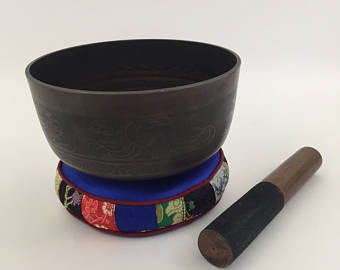
Source: Tashi’s Treasure
Similar to square cushions, round turban cushions are quite thick. In professional settings and sound therapy these cushions come especially in handy. For example, round turban cushions can be used to nestle the singing bowl near the client’s body. When using a round turban cushion, the bowl can be placed between the client’s knees, thighs, feet, or between their arms and body. These cushions should be about the same diameter as the bowl and will prove great support for your singing bowl.
Ring Cushion

Source: Dharma Shop
Ring cushions are debatably the most functional of all the cushion options while also remaining very pleasing to look at. As the name implies, ring cushions are donut shaped with a space in the middle large or small enough to fit your singing bowl. They are generally made from silk or brocade fabric.
With this particular kind of cushion, choosing the correct size is very important. If your cushion is larger than the diameter of your bowl, the singing bowl will sink into the ring and the sound will be dampened. If the ring is too small, the bowl will not be secured and will fall off when struck. Generally speaking, the cushion’s diameter must be 85% of the diameter of the bowl. A correctly sized ring cushion will create the best sound quality and keep your bowl safe from accidents.
Felt Cushion

Source: Himalayan Healers
Felt cushions tend to be the most functional and simplistic in style as well as the preferred cushion of many Nepalese Buddhists. Felt cushions have been traditionally used underneath singing bowls, provide a steady surface to rest on, and create clear, full sound. Most often, these cushions are hand felted by communities in the Himalayas.
While not appearing luxurious or sometimes even perfectly round, felt cushions should be considered your bowl’s best bet, as after time the felt will form to the shape that best fits your bowl. Felt cushions come highly recommended by many singing bowl sellers. Once your bowl is placed on one of these fine, thick cushions you will understand why they are tradition’s choice.
Temple or Cover Cloth
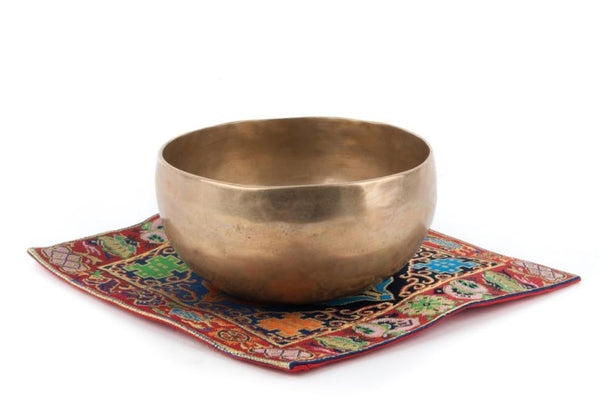
Source: Spiru Shop
Temple or cover cloths are less about functionality and more about what is customary for Tibetan singing bowls. In Buddhist temples and other places of worship, singing bowls are often placed on an altar cloth. Using an altar or cover cloth in your own space can provide quality sound as well as a display of traditional ambiance. However, due to the thinness of the material, they do not offer as much height or protection as other options listed here. However, these cloths can also cover the bowl when not being used, protecting it from scratches and preventing the buildup of dust.
Rubber Ring
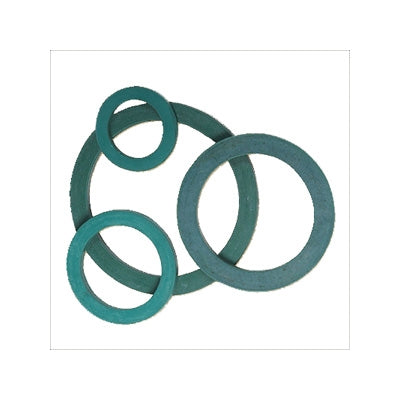 Source: Sound Travels
Source: Sound Travels
Similar to ring cushions, rubber rings are donut shaped and can be placed underneath your singing bowl to provide extra security while playing your bowl. They work best with crystal singing bowls. A correctly sized rubber ring will help stop your bowl from slipping around but may not be appropriate for all environments. The rubber rings are generally quite thin and require a sturdy, flat surface to be used. Their slim design, however, make these a good option when traveling to play your singing bowl for others.
Tibetan Wool Mat

Most similar to the felt cushions, these Tibetan mats are flat and made from wool in the Tibetan community in Kathmandu. When placed under a singing bowl, these mats help create an amazing resonance. Not to mention the care and artistry that goes into making each individual mat! Each mat is unique and handmade, making it not only functional but a special piece to add to your space.
Wooden Stand
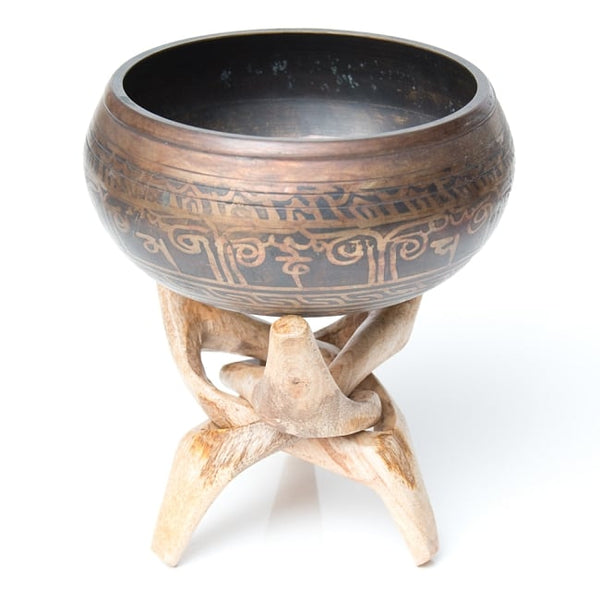
Source: Rakuten
For many of the examples of cushions listed here, they serve both a function and an element of style. Wooden stands, on the other hand, are recommended only for the display of your singing bowl. Wooden stands do not provide the necessary security and stability to be used underneath your singing bowl while playing it. As wooden stands are only recommended for displaying your singing bowl, the size of the stand should be to your liking, not necessarily the diameter of the bowl.
Zen Ultragrip Handle Tool
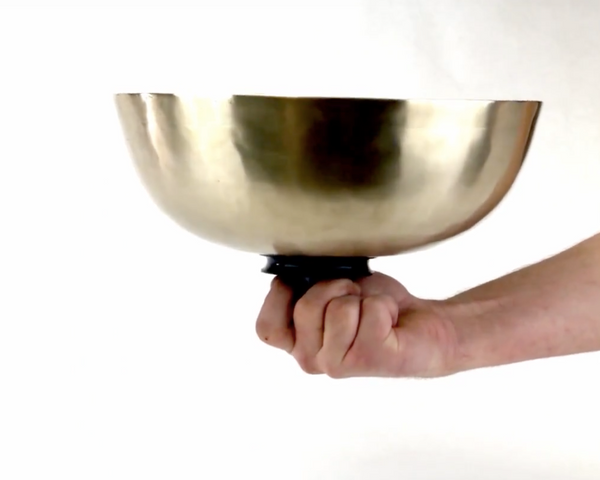
Source: Sacred Sound Shop
This last option for your singing bowl is the most modern among those listed above. Similar to PopSockets you might use with your cell phone, the Zen Ultragrip Handle Tool uses suction to attach itself to the base or center or your singing bowl. The Ultragip is strong enough to be placed on the inside or outside of the bowl. This is an option that should be considered if you use singing bowls in sound therapy practices that require you to move the bowl around a patient. Although the rubber is attached to the bowl, while moving and playing the bowl the vibration or sound should not be distorted or dampened.
In Summary
For the most part, choosing something to put under your bowl will be based on personal preference. Perhaps you prefer the look of something more elegant to display your bowl when not in use, like a brocade cushion. On the other hand, you might find yourself choosing practicality and functionality over beauty and choose a felt cushion. Either way, we hope this article has pointed you in the right direction when searching for the right singing bowl accessory for your needs and wants.
We invite you to get your own Tibetan singing bowl or crystal singing bowl today!
Did You Enjoy This Article?
Thank you for reading! If you enjoyed this article, you might also like the following articles: How to Play a Tibetan Singing Bowl and Singing Bowl Mallets and Strikers: Complete Guide

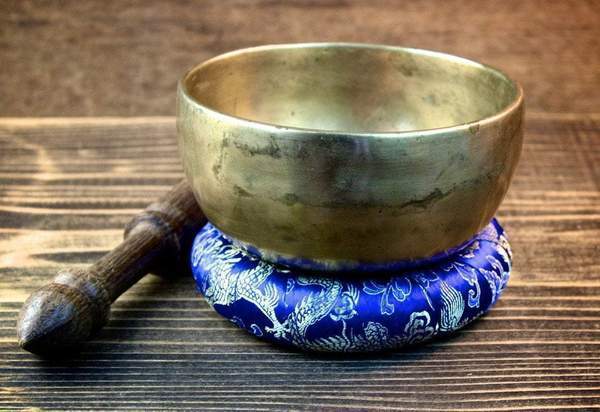
5 comments
Aug 01, 2022 • Posted by Donna Haston
Very informative….many thanks.
May 24, 2021 • Posted by Shanti Bowl
Hi DP, thanks for your question! Yes, a padded ring can work with a crystal bowl as well. Some people prefer the rubber rings, as they can ensure a better “grip” on the bowl and the surface below, whereas a padded ring is more susceptible to sliding. Something to keep in mind if you are playing your crystal bowl on a table and there is a risk of it falling. Hope that helps and good luck!
May 24, 2021 • Posted by DP
Hello, my crystal bowl comes with a rubber ring, will a round cushion help as well? I purchased it just in case but I want to hear some feedback please. Thank you.
Nov 18, 2019 • Posted by Shanti Bowl
Hi Gina, thanks for your message! You might be interested in our blog post on crystal singing bowls: https://www.shantibowl.com/blogs/blog/the-definitive-guide-to-crystal-singing-bowls
Nov 18, 2019 • Posted by Gina Miller
Is there a book learning to use the quarts singing bowls
Leave a comment